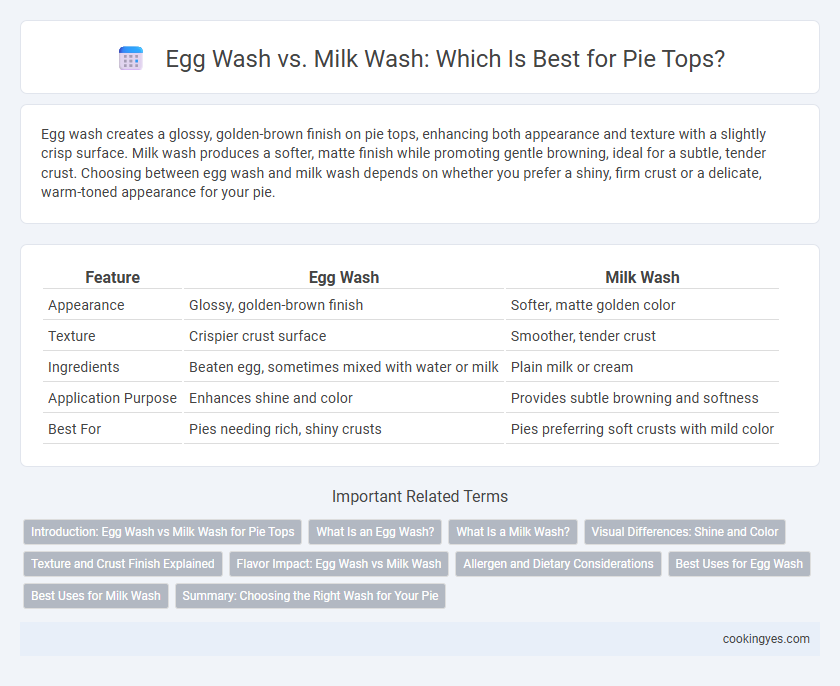Egg wash creates a glossy, golden-brown finish on pie tops, enhancing both appearance and texture with a slightly crisp surface. Milk wash produces a softer, matte finish while promoting gentle browning, ideal for a subtle, tender crust. Choosing between egg wash and milk wash depends on whether you prefer a shiny, firm crust or a delicate, warm-toned appearance for your pie.
Table of Comparison
| Feature | Egg Wash | Milk Wash |
|---|---|---|
| Appearance | Glossy, golden-brown finish | Softer, matte golden color |
| Texture | Crispier crust surface | Smoother, tender crust |
| Ingredients | Beaten egg, sometimes mixed with water or milk | Plain milk or cream |
| Application Purpose | Enhances shine and color | Provides subtle browning and softness |
| Best For | Pies needing rich, shiny crusts | Pies preferring soft crusts with mild color |
Introduction: Egg Wash vs Milk Wash for Pie Tops
Egg wash, made from beaten eggs sometimes diluted with water or milk, creates a glossy, golden-brown finish ideal for pie tops, enhancing both appearance and texture. Milk wash, often brushed on pie crusts, results in a softer, lighter color and a subtle sheen, contributing to a tender crust without excessive crispness. Choosing between egg wash and milk wash depends on desired crust color, shine, and texture for pies like fruit tarts or savory pot pies.
What Is an Egg Wash?
An egg wash is a mixture of beaten eggs, sometimes combined with water or milk, applied to pie tops before baking to create a glossy, golden-brown finish. It enhances the crust's appearance and adds a slight crisp texture, making the pie more visually appealing. Unlike milk washes, which produce a softer, matte finish, egg washes deliver a richer color and shine.
What Is a Milk Wash?
A milk wash, commonly used for pie tops, involves brushing milk onto the pastry before baking to achieve a golden-brown, slightly glossy finish. It enhances browning due to lactose and protein content, creating a tender crust without adding crispness like an egg wash would. Milk wash is ideal for delicate pastries and pies, providing a subtle shine without the heavier texture and rich color imparted by eggs.
Visual Differences: Shine and Color
Egg wash creates a glossy, deep golden-brown finish on pie tops, enhancing the visual appeal with a rich sheen and vibrant color contrast. Milk wash produces a softer, matte finish with a light, pale golden hue, offering a more subtle and rustic look. Choosing between egg wash and milk wash directly impacts the pie's surface shine and coloration, influencing presentation and perceived crispiness.
Texture and Crust Finish Explained
Egg wash creates a glossy, golden-brown crust with a slightly crisp texture, enhancing the pie's visual appeal and adding a subtle sheen. Milk wash produces a softer, matte finish with a tender crust that is less shiny but provides a delicate softness to the pie's surface. Choosing egg wash or milk wash depends on whether a firmer, lustrous crust or a softer, more muted appearance is desired for the pie top.
Flavor Impact: Egg Wash vs Milk Wash
Egg wash imparts a rich, golden-brown sheen with a slightly savory, custard-like flavor that enhances the pie's overall taste. Milk wash produces a softer, matte finish with a subtle sweetness that complements fruit pies without overpowering their natural flavors. Choosing between egg wash and milk wash depends on desired crust texture and flavor intensity, with egg wash offering a more pronounced savory depth and milk wash providing delicate sweetness.
Allergen and Dietary Considerations
Egg wash, containing proteins from eggs, poses allergen risks for individuals with egg allergies, making it unsuitable for those following egg-free diets. Milk wash, derived from dairy, introduces lactose and milk proteins, which can trigger reactions in people with lactose intolerance or dairy allergies. Choosing between egg wash and milk wash requires careful consideration of dietary restrictions and allergen sensitivities to ensure baked pies meet the needs of all consumers.
Best Uses for Egg Wash
Egg wash, typically made from beaten eggs sometimes mixed with water or cream, creates a shiny, golden-brown crust on pie tops, making it ideal for fruit pies that benefit from an attractive, glossy finish. Its protein content also helps toppings like sugar or seeds adhere better, enhancing both texture and presentation. Using egg wash is best for pies requiring a firm, crisp crust, such as apple or cherry pies, where a rich color and surface sheen improve overall appeal.
Best Uses for Milk Wash
Milk wash is ideal for achieving a soft, golden crust on pie tops, especially for fruit pies and custard-based fillings, as it adds subtle color without a shiny finish. Its natural sugars and proteins promote gentle browning and moisture retention, resulting in a tender, less glossy surface compared to egg wash. Milk wash is preferred for sweet pies where a delicate appearance is desired without the richness or glossiness that egg wash imparts.
Summary: Choosing the Right Wash for Your Pie
Egg wash creates a glossy, golden-brown finish with a slightly crisp texture, ideal for decorative pie tops and intricate designs, while milk wash yields a softer, matte finish with subtle browning. For rich, vibrant crusts, egg wash with a beaten egg or egg yolk mixed with water or milk is optimal; for a more muted appearance and tender crust, brushing with milk alone suffices. The choice between egg wash and milk wash depends on desired crust color, texture, and visual appeal to complement the pie's filling and presentation.
Egg wash vs milk wash for pie top Infographic

 cookingyes.com
cookingyes.com